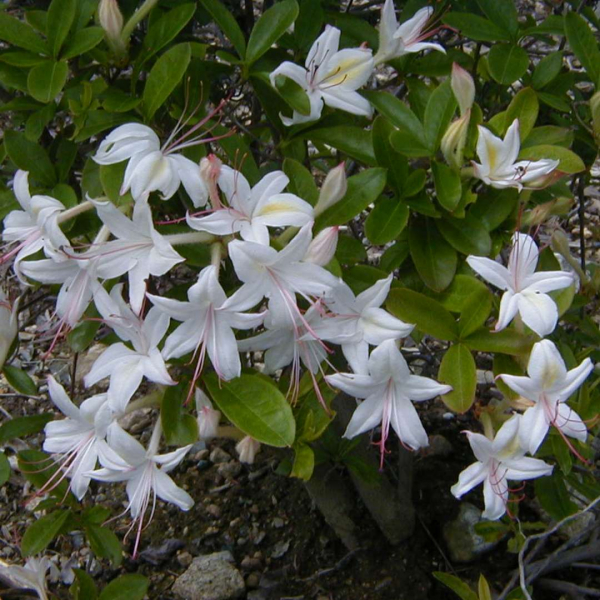Evergreen Azaleas, with their explosion of colorful spring blossoms, are a welcome sight when winter releases us from its frosty grip. Deciduous Azaleas can bring to your property fantastic scent as well as summer-long blooms. Many deciduous hybrids begin flowering long before summer begins and carry their beauty into the fall with brightly colored foliage. Generally speaking, evergreen Azaleas have a mounding growth habit while deciduous grow more upright. As garden plants, Azaleas are versatile and require little care. If planted in a rich soil, in a protected location, they will thrive for decades.
Soil and Moisture: All Azaleas prefer rich, humusy, acidic soil that drains well. Since they are shallow rooted, it is easy for them to dry out and, at the same time, drown if over-watered. Sandy or dry soil should be amended before planting as should heavy clay; add peat moss, peat humus or compost to remedy the problem. If the soil is well prepared, the plant will succeed. Note that Azalea viscosum (deciduous) will tolerate damp areas. Mulching will help retain moisture, smother weeds, and cool the soil.
Sun: Evergreen Azaleas prefer partial shade where they are protected from harsh summer and winter sun as well as wind. Planting them in a protected eastern or northern exposure is preferable to western or southern. However, a southern exposure can work if it is shaded, the soil is rich, and the plant is protected from wind. Many will tolerate deep shade, although they may become leggy and not flower as heavily. Deciduous Azaleas prefer full sun but will tolerate light shade. If planted in shade, they will become open branched, flower less profusely, and be prone to powdery mildew and fungus. Azalea arborescens, Azalea viscosum, and Azalea vaseyi, however, will tolerate more shade than others.
Insects: Evergreen Azaleas are rarely bothered by insects, but black vine weevils and lacebugs can find these plants desirable. The larvae of the black vine weevil live within the soil and attack Azalea roots and stems. They can even girdle the stem of the plant, removing bark and killing the plant. The adult insect may eat the leaves of the plant but prefers Rhododendrons. Lacebugs (small, almost transparent beetles) will feed on the underside of the leaves causing them to turn grayish. Deciduous Azaleas, too, can be attacked by black vine weevils, Azalea stem borers, and Azalea leaf tiers. The adult form of the black vine weevil cuts notches into the leaves, sometimes leaving nothing but veins; the larval form attacks the roots and stem of the plant. Azalea stem borers enter the tips of stems and bore out some of the twigs soon after bloom time. Azalea leaf tier are caterpillars that roll the leaves up and feed on them. All of these pests are controllable with insecticides.
Diseases: Evergreen Azaleas can be attacked by fungal diseases, although well drained soil and proper maintenance will help prevent them. If the soil stays too damp for extended periods of time, Phytophthora root rot can become active. Leaves on an infected plant will curl and brown and appear dry. The plant is not dry, however, but affected by extremes of soil moisture. Improving drainage is the best way to prevent this fungus.
Leaf spot fungus appears as brown circles on the leaves; wet weather and overhead watering create the proper climate for this problem. Watering with a soaker hose instead of sprinklers will hold this fungus at bay.
Powdery mildew will attack evergreen Azaleas if conditions are right—when the air is damp or when the plant is shaded—and appears as a white coating on the leaves. Overhead watering should be avoided and a sunnier planting site selected.
Deciduous azaleas can be attacked by Phytophthora root rot and powdery mildew. To control most fungi, a systemic fungicide should be applied during wet springs.
Fertilizing: Azaleas usually require little supplemental feeding. A balanced fertilizer such as Holly-Tone or Broadleaf-O-Ganic can be applied conservatively each spring.
Pruning: Spent flowers can be removed to promote new growth but is rarely necessary. Evergreen Azaleas rarely require pruning, but if necessary should be pruned right after flowering. Deciduous Azaleas require pruning only if the plants become leggy and should be done right after flowering.
Winter Protection for Evergreen Azaleas: In challenging locations, evergreen Azaleas may benefit from winter protection. If the site receives full sun and or the site is windy, an application of an anti-dessicant spray such as Wilt-Pruf can help prevent the plant from drying out. Providing additional water in the fall, if the season is dry, will also help. In our climate, evergreen Azaleas are often considered semi-evergreen and may lose up to half their leaves. They may look a bit scruffy in the spring, but will recover quickly. Many times an Azalea that has lost most or all of its leaves after a harsh winter will leaf out and perform admirably. In some cases, the plant will flower heavily, but have no foliage until new growth is pushed out. Weston Nurseries has introduced a number of zone five Azaleas that were developed for durability. ‘Bixby’, ‘Herbert’, and ‘Majesty’ are three such introductions. If you live west of Route 495, you might want to consider these plants. Even though more root hardy than others, they should be considered semi-evergreen. Deciduous azaleas usually need no special winter care.








